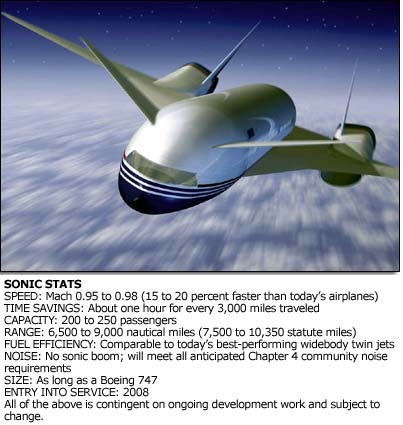|
THE NEED
FOR SPEED
Boeing's Sonic Cruiser team focuses
on the future
BY LORI GUNTER

Behind the doors of the Bomarc building in Everett, Wash., Boeing employees
are shaping the future of commercial aviation. They do so in the shadow
of an industry in turmoil. It's a task no one takes lightly.
Next to the model of the futuristic Sonic Cruiser are huge photos of
the beginning of Boeing — women stitching fabric wings, the red barn
where it all started, and the large World War II production facility in
Renton, Wash., that put Boeing into the aviation game to stay. This contrast
of history and future helps keep the team focused on the need to "get
it right."
"When you go first, you have to be right," said Walt Gillette, vice president
and general manager of the Sonic Cruiser program, speaking recently to
a group of employees at an all-hands meeting. "If you're wrong, you're
just pointing a big arrow at where the competition needs to go. But if
you're right, you've opened the door to tremendous opportunity for yourself."
Shaping the future of flight
Gillette has compared the design of Boeing's proposed Sonic Cruiser high-speed
commercial jet airplane to a symphony.
"It all has to work together," he said. "It works in a much more integrated
fashion than a conventional configuration.
"The Sonic Cruiser is a brand-new class of flying machine," Gillette
said. "Every other commercial jet airplane has been a further refinement
of the 707. We have more than 50 years' experience with that class of
flying machine; we have just over a year of experience with the Sonic
Cruiser class of flying machine."
 Yet
in that year's time, the team has made tremendous strides in understanding
how the parts of the airplane work together. Yet
in that year's time, the team has made tremendous strides in understanding
how the parts of the airplane work together.
For example, advanced computational fluid dynamics technologies are helping
to refine the configuration of the Sonic Cruiser for optimum efficiency.
"On a conventional design, you can change the shape of the wings or the
length of the fuselage without having to worry much about the rest of
the design," Gillette explained. "On an airplane that travels just under
the speed of sound, the design doesn't work that way. A small change to
the shape of the wing, to the angle of the canard [the control surfaces
near the front of the airplane] or the fins [at the back of the airplane]
means you have to make changes to the other parts of the airplane as well."
Gillette said the team now has a good understanding of how all the parts
work together and what changes to one part necessitate change for the
rest of the airplane.
"We could not have worked on this design even five years ago," he said.
"The computational tools are just now robust and sophisticated enough
to allow us to do this work."
Airline industry in turmoil
While the design tools are robust, the airline industry certainly doesn't
appear to be. A scan of the financial reports of the airlines for the
last year paints a bleak picture. Most airlines are literally losing money
on every flight. Those making money are not making good margins.
This is leading some to question how Boeing could be considering introducing
a new airplane, much less a new class of airplane, into a financially
weak market.
"One thing that Boeing has always been able to do is see through the
current crisis," said Dan Mooney, vice president of Product Development
for Boeing Commercial Airplanes. "We saw through the era of the late 1960s,
when airlines were not ordering airplanes, and we invested in the 747,
which continues to be an outstanding airplane. We saw through the even
deeper hole of the early 1970s and prepared to launch the 757 and 767
together by the end of that decade. We saw through downturns in the 1980s
and 1990s and developed airplanes that are still considered the best in
the world."
Mooney said that a great deal of emphasis is always put on getting Boeing
through industry downturns. By placing equal emphasis on being positioned
for the inevitable industry upturn that follows, Boeing has thrived.
"We believe that when the next upturn begins, the airlines will be ready
for the Sonic Cruiser," Mooney said. "If we wait until then to start working
on it, we will be too late. It has to be ready to go when they want it."
Building on a legacy
In addition to missing the market if it waits, Boeing may very well lose
its ability to create a new airplane.
Industry experience indicates that if the company doesn't create a new
airplane about every 12 to 15 years, the needed skills and experience
will be gone. Too many of the people who created the last new airplane
will have retired or moved on to other companies, and their skills and
experience will not have been passed on to the next generation of Boeing
employees.
"The time is right for us to do a new airplane for so many reasons,"
Gillette said. "The technology is right, the market will be right, and
our people need to use those skills to keep us competitive."
Gillette keeps his team focused on the role the program will play in
Boeing's history.
"Boeing has changed the way the world flies before," he said. "It's time
to do it again."
lorretta.m.gunter@boeing.com
|